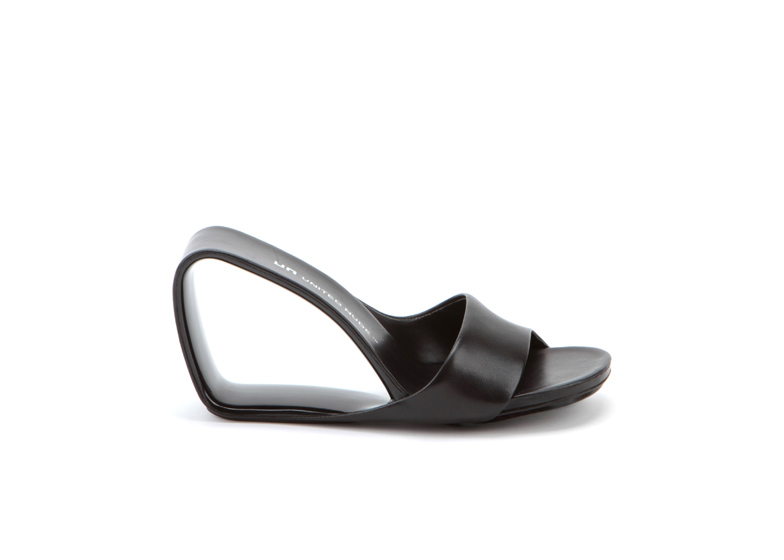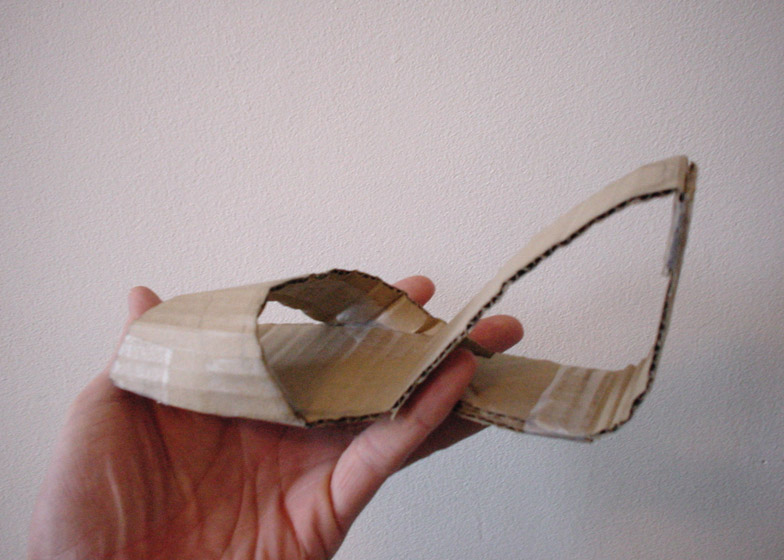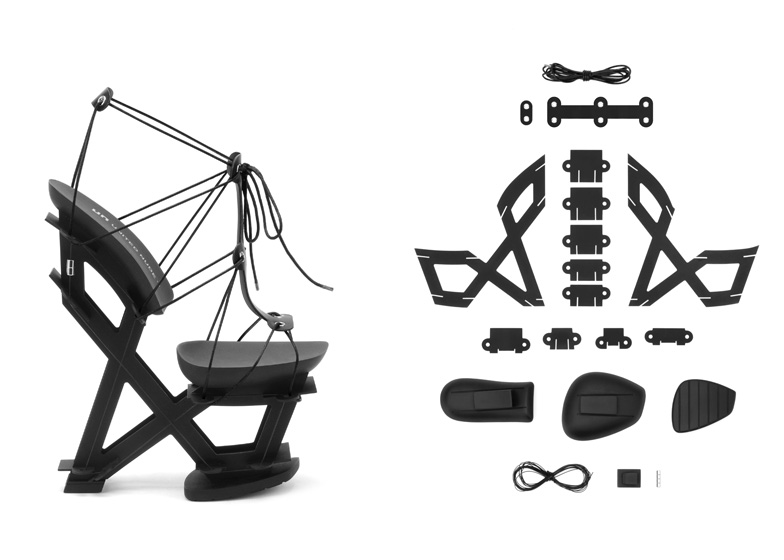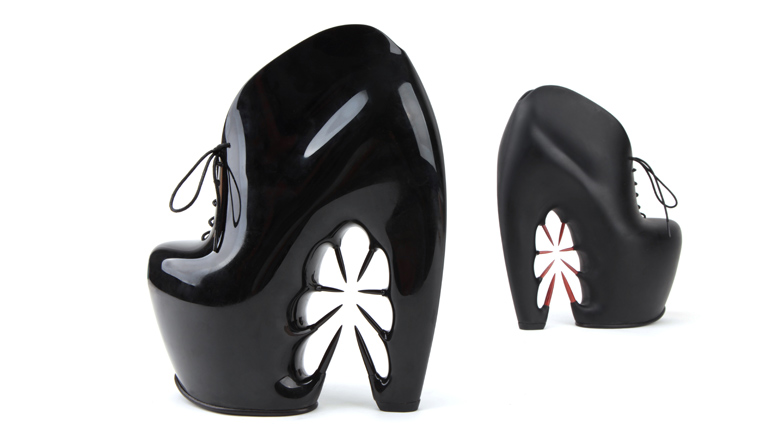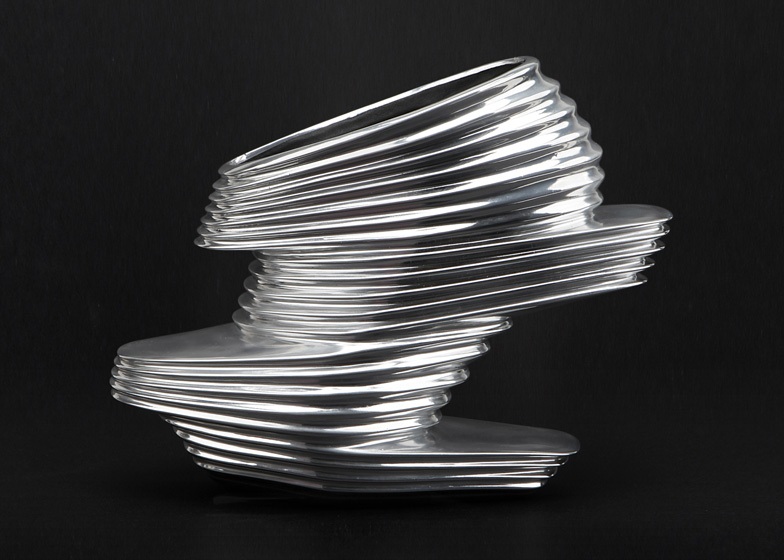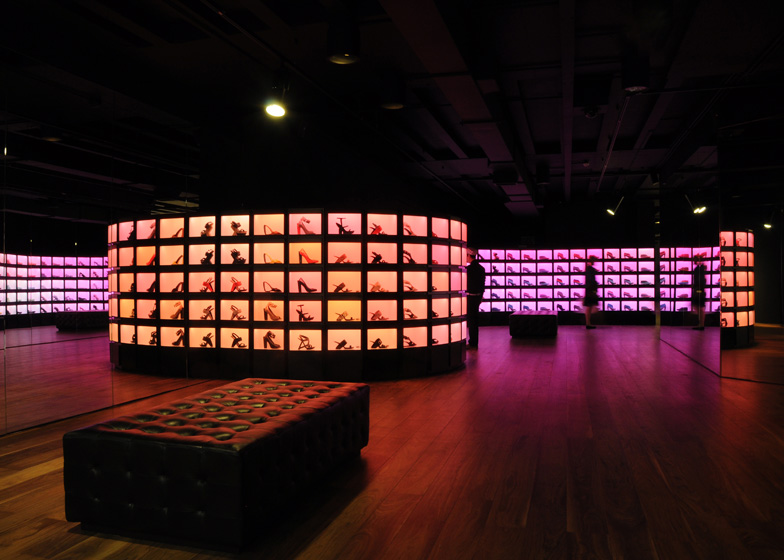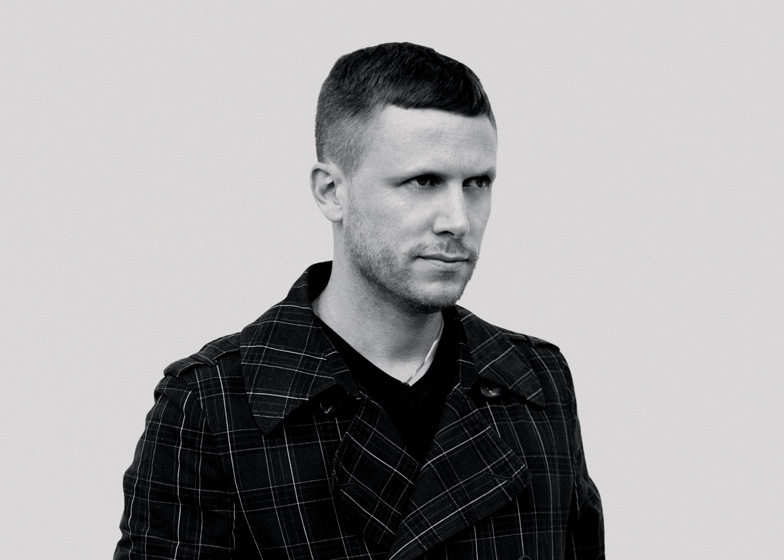Interview: architect Rem D Koolhaas launched footwear brand United Nude ten years ago with the radical Möbius shoe. In this interview he explains how he developed the product, discusses "extreme theatre" shoe collaborations with Zaha Hadid and Iris van Herpen and talks about the future of 3D-printed footwear (+ slideshow).
Koolhaas, the nephew and namesake of architect Rem Koolhaas of OMA, came up with the Möbius shoe in 1999 while still studying architecture and was persuaded to start his own brand - United Nude - because the design "didn't look like anything [else] out there".
He had to develop new industrial production techniques to make the shoe, which he describes as "the first high heel to cross the border between industrial design and fashion".
As well as developing the shoes, Koolhaas designs the brand's signature retail outlets and continues to try new ways of designing and making footwear. Most recently he has experimented with 3D-printing, although he says: "I think will take quite some time for 3D printing to be a [viable manufacturing method] for shoes".
Here is the full transcript of the interview:
Marcus Fairs: It's the tenth anniversary of United Nude – tell us a bit about yourself and how you started the brand.
Rem D Koolhaas: I was studying architecture at the time in 1999 when I was heartbroken over a girl. I was finding myself drawing shoes and then I came up with the Möbius shoe [featuring a hollow, loop-shaped heel and a second loop across the front of the foot], which was quite a fresh thing at the time.
I showed it to a lot of people at the time and everybody was saying that if I wanted to make the shoe for real, the only way to do it was to start a new brand, because it was nobody else's signature.
I spoke to Prada because I was working for my uncle [Rem Koolhaas of OMA] at the time on the Prada store in New York. I spoke with [shoe designer] Sergio Rossi – with all sorts of people in the industry – and they were all saying the same to me. They were saying "look, it's a great design but if you want to make it, you have to start your own brand because it doesn't look like anything out there".
Then a mutual friend introduced me to Galahad Clark [of UK shoe brand Clarks], who is a seventh-generation shoemaker. He was the first to propose the idea of starting a brand together, which is something that we then did. We started developing the shoe while I still had to graduate for my architecture degree in Delft. I went to Italy and developed the shoe and it took us quite some time.
Marcus Fairs: What was different about the Möbius shoe?
Rem D Koolhaas: It required new construction methods, using new materials for a shoe with new silhouette. It was the first high heel to cross the border between industrial design and fashion. The shape of the Möbius shoe was so simple but we had to invent a new way of shoe-making for it. Working with some of the world's most advanced shoe technicians in Italy was crucial. The materials we used had also never been used before to even make shoes. The long fibre-reinforced nylon heels needed hardened steel moulds, which we ended up making with a car-part mould maker.
Marcus Fairs: Did you complete your architecture studies?
Rem D Koolhaas: Yes I did. I did a project where I divided architecture into five different scale levels and I made the Möbius shoe one of the scale levels of this project. So I graduated and then I used those images for the campaign for the shoe, which was kind of a double agenda.
As soon as I graduated in 2001 - just after the World Trade Center came down actually - we continued with the development of the shoes. In early 2003 we had the first shoes in the stores. It was a huge success because it was a very revolutionary shoe at the time. I bought shoes from those times to learn from them and to study how they were made, and the shoes that I bought were extremely boring. There was not much going on in shoes in 2003. The most exciting thing going back then was Prada Sport – Prada did have some cool shoes but that was about it.
So we had tremendous success launching the brand with that shoe because everybody wanted it because it was so fresh and so new. We had it in some of the most prestigious accounts in the US, in Japan, in Paris. We had it in Jeffrey in New York, Selfridges, Liberty – everywhere. It was a huge hit.
Then we had to turn one shoe into a company, which was probably harder to come up with more shoes. We kept on trying more things in architectural footwear, leading us to last year when we started to speak to several architects about working together.
Marcus Fairs: How did the collaboration with Zaha Hadid come about?
I think that Zaha is one of the most important architects of today as well as the most important female architect by far – and she also loves shoes. I was introduced to her a couple of years ago at a dinner in Kong Hong Kong and I had already heard that she really loved United Nude, so I spoke to her about shoes a little bit and then I gave her a pair of shoes. I became friends with some of the people who worked for her and they came to the store opening in London. That's when one of the main guys at the office there said to me "when are we going to do a shoe for United Nude?" and I was like "well, any time you want really".
That's how that ball got rolling – we started talking about what to make and how to make it, then I came up with a brief to make a shoe that didn't look too much like a shoe. I wanted to have quite a sculptural shoe and something with some volume and I would think about how to make it.
It started as a 3D-printed shoe project and we were talking to all sorts of 3D printing companies. Then all of a sudden the material we wanted to use became unavailable and we had to change the whole project to a different method.
We were working on several shoes with Zaha, so we changed from the chosen design to another one because we were not going to 3D print it. It wasn't a very exciting shape if we were going to 3D print it but it's a very exciting shape if you make it in a different way and if it is chromed because it will look like a beautiful metallic object.
So I came up with a new way of shoemaking for it, which is the use of rotational moulds, which allows you to make a very thin outer shell, which becomes a second layer of the shoe and can be independent for quite a big extent. It's a very eye-catching design.
The new pictures show a more reflective chroming. They really look extremely expensive for instance when you see them. They look like these beautiful objects that hardly look like shoes and when people find out that they are shoes, there's a big surprise there, which is one of the reasons I really like them.
Marcus Fairs: You mentioned that when you first started that the shoe industry was pretty conservative – and it still is really. There are a few interesting brands out there but how receptive are the shoe buying public to radical ideas now? Could Zaha shoes become a high-street product or are they a limited edition statement?
Rem D Koolhaas: It's a limited edition statement shoe but for United Nude we do have some shoes that are not as radical as the Zaha shoe. We have some very extrovert shoes that actually are selling quite well. This has something to do with the price they have to pay for it and how crazy they are, but there is a market for extreme shoes, but of course, there's not a huge market.
The groups that are really attracted to these kind of extreme theatre pieces almost are, for instance, transvestites. They always come and ask if we make the shoes size 43 or 45, because they are the ones that are dressing like Lady Gaga. There are thousands of transvestites that do that because it's part of who they are – to dress up in a very expressive way.
Of course there's very cool fashion people that are not afraid to dress up and show off wearing crazy stuff, it's just a pity that there aren't more people that like dressing up in a more extreme, futuristic way.
In Japan you see a lot of people that dress really crazy and they are less afraid of it. I think that's why Japan is the most fashion-forward market in the world.
Marcus Fairs: You also collaborated with fashion designer Iris van Herpen on a 3D printed shoe. How viable is 3D printing for the mass production of shoes?
Rem D Koolhaas: Well that shoe was actually designed for a different 3D printing method. Because we were running out of time and some of the people we thought we could rely on lacked capacity, we had to change method. The original method I had in mind was probably more suitable and has a bigger chance of becoming a mass-market type of printing.
I think that 3D printing is still so expensive and so time consuming using a high-quality printer that I think it will take quite some time for 3D printing to become a [viable manufacturing method] for shoes. I saw for example something on Dezeen – the 3D printed casts - that are something really smart and for things like that. As long as the insurance is willing to pay for it, it could work.
But I think it's really tricky for shoes because you have to use the softer materials if you want to make the shoes comfortable. The only method that would work and allows for that is the laser-sintering method, which is also the most expensive printing method; you're talking about machines that are worth in excess of $100,000 so I wouldn't put my money on it for the short term. But who knows for the long term.
Marcus Fairs: Why is the brand called United Nude?
Rem D Koolhaas: It stands for that we are working together in a team and that we collaborate a lot in an open and transparent way. Beautiful things can happen when you are United Nude.
Marcus Fairs: You personally design all the United Nude stores, is that right? Tell us about the concept of the stores. Do they have a similar concept and look all around the world, with the backlit shelves on the wall?
Rem D Koolhaas: That's our main concept; we have some other concepts that we mix in from time to time. Our main concept is this dark shop concept where the shops are basically designed as theatres and the products are the performers - the show. There are only lights where the products are and we designed and developed what we call a wall of light, which is a very low-resolution screen where each pixel is basically a little box with a shoe in it. We can run low-resolution images or animations on the screen which looks very like a very abstract sort of pixellated colour scheme.
It's very theatrical and very easy to recognise and to remember. I designed the stores based on some of the experiences I had working on the Prada concept store. We worked on the conceptual space and spoke about how shopping in the future has to be more about experience if it's going to compete with online shopping.
If you want to create a shop for a brand such as Prada or United Nude, you have to give it a lot of identity and make it not look like anything else. You want people to know that they are in your shop and not to get confused that they are in somebody else's shop. It's really about brand identity and about shopping experience, which works quite well.
Our shop in London gives you a special feeling where you're not really sure if you're in a shop, theatre, or gallery – whether it's a temporary or permanent space. The shops are set up as an installation. Most of the components are free-standing and so we could change them around quite easily, even though we hardly ever do that because we are running a shop.
We are opening quite a few of them every year and there are people that own shopping malls around the world that want to have this shop in their shopping mall. They understand that shopping is about experience and so they want cooler shops with more experience.
Marcus Fairs: There's a lot of discussion about how internet shopping is supposedly killing the high street. Why do you have physical stores and how do you strike the balance between physical and online sales?
Rem D Koolhaas: What we do to make it work for now is to operate the online sales from our shops. Not always, but we share all our stock in the computer system. If, for instance, somebody in the UK orders a pair of shoes online, we look first in our shop and send it from our shop. I think this is a good way of keeping the shops busy as well. If the weather is bad and you're not on a busy street, your shop can be empty for a while. So it's a good way to keep them busy.
Marcus Fairs: Do you ever plan to collaborate with the other Rem Koolhaas on a shoe?
Rem D Koolhaas: Perhaps. Before we started working on this shoe with Zaha, I wanted to do a project with a number of designers as it was going to be 3D printing and an easier kind of shoe development. It was set up as a 3D-printing shoe collaboration where we could perhaps print shoes in our stores - although now I know more the practicalities make it slightly harder and they are not the most showy of machines. I was talking to several architects at the time to see if we could collaborate with some crazy architects making shoes, and I was also talking to the other Rem.
Marcus Fairs: Something might happen in the future?
Rem D Koolhaas: Who knows, it's not in the making yet. He hasn't seen the Zaha shoe yet but I can imagine when he sees it, he'll get very excited. I spoke with him about it; he didn't say no and he didn't say a big yes! I think he was just waiting to see how this one went.

